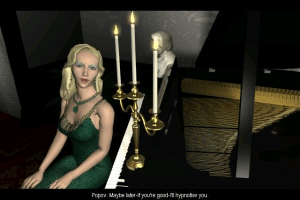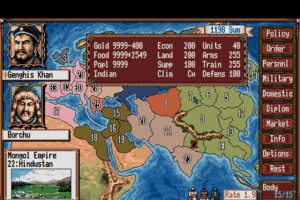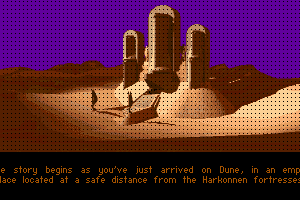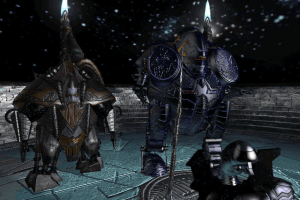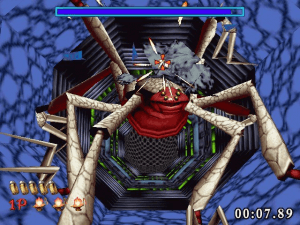Avalon Hill's Squad Leader
Windows - 2000
Description of Avalon Hill's Squad Leader
PLEASE NOTE that the game reviewed here, even though its box reads Avalon Hill's Squad Leader, bears no resemblance to the excellent boardgame of the same name, beyond the common WWII historical setting. If you're looking for a conversion of that game to the PC, the closest thing available as of this writing is Combat Mission: Beyond Overlord, by Big Time Software.
SANTA HASBRO
Looking forward to new games reminds me of how I felt anticipating Christmas as a kid. Learning about a game with potential before it's released inspires the same hope for magic and fun as the presents under the tree, concealing their contents until the big day. The problem is, whereas the Santa Claus of my youth was a genial, bearded saint with a twinkle in his eye who listened patiently and responsively to my annual list of demands, the Santa Hasbro of the gaming industry is some guy in a suit with too much product in his hair and a degree in Marketing, who cares more about the appearance of a game's box than the magic that may or may not be captured therein. In lieu of a canvas sack chock full of goodies, he totes a briefcase stuffed with cash, and somewhere among all those bills is the $50 US I paid for Squad Leader.
Fifty dollars. I'm still stunned by that price.
GETTING ON WITH IT
Squad Leader is a squad-level, turn-based game of World War II combat, featuring the fourth iteration of a game engine first employed by Random Games(the developer) in the service of Wages of War. After that game, it was used for Soldiers at War, also set in WWII, and then Warhammer 40,000: Chaos Gate, which departed from a real world setting in favor of battles between armored Space Marines and the legions of Chaos. Many people, myself included, found Soldiers at War frustrating and unplayable. Although still somewhat clunky and problematic, Chaos Gate outdid its predecessor and turned out to be a fun and entertaining game. This apparent step up in quality is what got me thinking that Squad Leader had a shot at being good, or even great.
In Squad Leader, the player controls a number of soldiers and vehicles, maneuvering them on an isometric, multi-elevation battlefield against an enemy force in an effort to accomplish whatever victory objective may be at hand. The player can choose between stand-alone missions (custom-made or randomly generated) or one of three campaigns (The Americans in Normandy, the British in and around Arnhem, or the Germans in the Ardennes). The editor, which did not ship with the game but is planned as a free download at some point in the future, promises full mission and campaign creation. There's a tutorial that walks the player through the impressive range of unit actions, which include walking, running, crawling, standing, crouching, lying prone, snap fire, aimed fire, direct fire, picking up and dropping items, throwing grenades, setting demolition charges, engaging in hand-to-hand combat, embarking and disembarking from vehicles, rallying broken soldiers, calling in artillery, crewing heavy weapons, and more. Opportunity fire is implemented, allowing a soldier to fire at a target of his choice during the opponent's turn if he has enough Action Points left. Coupled with the range of possible mission scenarios and the profusion of weapons and vehicles at the player's disposal, this is a feature list that squad-level, turn-based fanatics like myself dream about.
The manual is straightforward and functional, refreshingly specific in some areas but utterly lacking in others. For example, while actual equations are given for how the game calculates a soldier's throwing range or firing accuracy, no clear description is given of the mysterious rating "Combat Effectiveness," or the method of determining the distance within which Leadership bonuses or the Rally command apply. This inconsistency carries over into the game itself, although there, unfortunately, the bad examples far outweigh the good.
UNDER THE WRAPPER
The game opens with a computer animated intro that I think is pretty bad. I've always believed that animating or rendering humans in high-res 3D is a mistake in any game, and in the case of a period piece like Squad Leader, it's downright laughable. The soldiers have no character and move in groups obviously composed of identical 3D models going through identical animated steps. I would much prefer tasteful still montages or hand-drawn art to this lifeless and imagination-crushing aesthetic, but it's rife in the gaming industry, so I shouldn't single out Squad Leader for it. And who plays a game for its cutscenes, anyway? [There's ANOTHER reason for playing Command and Conquer or Wing Commander games..? -Ed]
The menu, mission briefing, and platoon and equipment selection screens are functional and well-done, with pop-up explanatory text for every button. The player can select from four difficulty levels, the hardest one being a carryover of the Iron Man mode from Chaos Gate, one of my favorite features of that game. In this mode (called General in Squad Leader), only one savegame slot is allowed, and the game automatically saves over itself every time a soldier is wounded or killed. I wish this option was included in more games, since it really ups the tension and forces careful consideration of every action, intensifying the accomplishments and disasters of your soldiers on the battlefield.
The eight available Squads come in two flavors: six of riflemen and two of heavy weapons experts, each composed of four soldiers and a squad leader. Additionally, there are Specialists, which include a Platoon Leader, Assistant Platoon Leader, two Radio Operators (for calling in artillery), two Medics, two Snipers, and two Combat Engineers. This makes for a total of fifty different men to command, who are chosen randomly (with statistics generated anew) from a pool of 100 for each nationality whenever a new game is begun. The player can freely exchange soldiers between positions, to tailor squads as he sees fit.
Each man has a name (which is editable), portrait, age, town of origin, a brief biography to give him some flavor, and is rated in six statistics: Action Points, Accuracy, Morale, Initiative, Strength, and Leadership. In addition, each holds a rating, from Green to Elite, which can increase with experience and boost the soldier's base statistics.
Some good effort has been put into individualizing the soldiers through their portraits (again rendered in 3D, with slightly more success than the cutscenes) and bios. Soldiers' voices are generic for each nationality, which is no surprise given the large number of men in play; the German soldiers sound good, partly because they speak German (subtitles can be toggled), and the British soldiers sound okay, but the Americans sound like a bunch of whiny pansies.
The statistics system is a little hard to get a handle on, because instead of establishing a standard range (say, 1 to 100) for all of them, each attribute seems to have its own scale. For instance, 40 is a very high Accuracy, 78 is a very high Strength, and 9 is a very high Leadership. It's as if the designers approached every in-game algorithm separately from the desired end result and scaled each statistic to fit, instead of starting with a universal statistic system as a foundation and building the game rules out from there. The best pen-and-paper RPGs apply this latter theory to good effect; it allows the characters to become the hub of the rule system and encourages greater player connection and comprehension.
A further effort to individualize soldiers takes the form of letters from home, which some of them may receive between missions, an option (you can turn it off) intended to add color and some extra-curricular psychological effects to the game. The idea is that, for example, a soldier who learns a family member has passed away may lose his will to fight and refuse to respond to orders. This is an interesting inclusion and I welcome the attempt to introduce something novel to the genre, but the end results are mitigated somewhat by the fact that a soldier who receives a bad letter can simply be transferred to a squad that's not going to see any action in the near future.
INTO THE FRAY!
There are a variety of mission types, and each mission has different squad, specialist, equipment, and vehicle limitations, so they can range from single-squad engagements to large battles involving dozens of men and multiple vehicles per side. Combined with customized maps and victory objectives, the game offers a rich array of gameplay possibilities. It all sounds quite wonderful -- all of the ingredients for a great game, really. And then you play your first mission.
The flaws are legion and with you from the first turn. The resolution is fixed at 640 x 480, and the game's artists were so much more absorbed with texture and detail (which is lovely) than any kind of overarching visual order that it's often hard to locate your troops, and well-nigh impossible to discern elevation slopes away from your point of view. This is at the closest zoom level; the higher zooms exacerbate this problem by orders of magnitude, remaining as they do at the same 640 x 480 resolution. The engine allows you to cut away levels of elevation for more easy viewing, but this method was clunky in its previous incarnations and remains so here, forcing you to construct a 3D visualization of the battlefield in your own head in order to get any sort of inkling as to what parts of the map are visible from where.
The interface setup is standard for this sort of game, with soldier data and numerous buttons along the bottom of the screen, and a view of a portion of the battle map taking up the rest. The control system is simple enough, requiring the player to click on a soldier, click on an action button, and then click on an object or destination for the action. There are hotkeys (configurable) for all of the onscreen buttons, so if you want you can just use the mouse to indicate the destination for a chosen action. In fact, you'd better just use it for that, because clicking on a button often has no effect, even though it may make a little noise and turn "unlit" in order to indicate that it's been pushed. A second click will turn it "lit" again, but may or may not produce the desired ingame results. So... hotkeys it is, then.
Mouse responsiveness is interminable. Apparently the game is a massive resource hog, which is astounding given its isometric, 2D aspect and limited resolution, as well as all of the time the coders have had to optimize the engine. The position of the mouse pointer on the battle map is indicated by a green box cursor outlining the terrain square (or "cell" in SL parlance) under it, and this cursor "hugs" the terrain as you move it around. The same cursor in Chaos Gate gave important feedback, including a red "X" to indicate a square that was not traversable. Not so here, where it's needed even more thanks to the indiscernible mess of bushes and tree trunks featured on many of the maps. Moving it can be very laggy, and a long click on the target square is often necessary in order to make it register. If you want to target a cell above ground level (like the turret of a tank, for instance), you can use the A and Z keys to move the cursor up or down between elevation levels, but this method is jittery and inconsistent.
The minimap deserves special mention for its intemperance and obscurity. Theoretically allowing an overview of the battlefield, and one would hope some clue as to where, say, vision-obstructing trees are located, it instead represents the mission map according to the color of its terrain tiles. So grass is green and piles of autumn leaves are nice patches of orange, but trees, or any form of cover whatsoever, are not depicted at all. There is also no rectangle on the minimap to indicate where the "camera" is located at any given time, which renders it useless for purposes of orientation. The lack of these things is inexplicable, since the minimap in Chaos Gate featured both of them. It also consistently closes down every time a soldiers exits the map and every time you save your game. You will come to think of the minimap as a sort of malevolent Tinkerbell, fluttering in the corner of the screen, forever plotting some new way to aggravate you.
TAKE COVER!
All this and you still haven't moved a soldier. Go ahead, I dare you. Watch how your British paratrooper staggers across the landscape, sluggish even though you've maximized the unit animation speed on the options screen, slipping frames or lurching suddenly forward, according on the whim of whatever cruel homunculus is pulling his strings from in amongst the lines of code. You order him into a prone position, and then to continue ahead at a crawl. A shot rings out! More accurately, something like a pencil tap on a desktop is heard. You will discover soon enough that every single weapon sound effect is as pathetically quiet, drowned out by the other noises in the game, from ambient background sounds to the footsteps of your soldiers. How this massive oversight went unnoticed by even a single playtester is beyond me. I managed to raise the mp3 levels to an acceptable level using an external audio editor, but most people won't have the inclination or paitience for that. It's a miserable gaffe on the part of the developers, because the weapon sound effects are quite good when heard at the proper level.
Anyway, your man is hit, and convulses in death, crying, "I'm... killed." before he expires. Where the !@#! did that come from? And who the !@#! wrote that man's last words?
The line of sight system employed in Squad Leader is the same as the one in Chaos Gate, and I think in Soldiers at War as well. It abides by none of the real world factors (successfully modeled in other games) you might intuitively expect, like distance to target, amount of cover between spotter and target, time of day or weather (neither modeled at all in SL), stance of target, etc. A soldier has a 180-degree range of view, and if the program can trace a line from his head to any part of a target's body within that range of view, regardless of other factors, the target is spotted. This appears to apply also to tanks! The end result is a lot of unbelievable sighting situations. In the scene described earlier, a German soldier had spotted your man from a distance of 26 squares, over a stone wall, down an elevation level, through a window on one side of a house, and out a window on the other side of the house. Remember that your man was crawling belly to the ground. I think this summarizes the basic problem of LoS in Squad Leader nicely.
The reason that players, myself included, were more forgiving of this system in Chaos Gate is that that game had a science fiction setting and consisted of bulky, powered armor-wearing units stomping around, firing gigantic plasma bolters at one another. The high-tech setting allowed for a greater suspension of disbelief, because we could always assume the Space Marines had vision enhancers in their helmets or something. SL asks that we try to immerse ourselves in a believable WWII setting, where being seen or not seen is a vital issue, and then tells us a man lying prone in the underbrush can be spotted all the way across the largest size map if even only his feet are visible. And then killed in one shot.
Although the similarly flawed accuracy system assists in the denial of player immersion, at least its variables (such as soldier and weapon statistics) are tweakable by the user in the included rules files. This allows some room for the hearty who surivive the game's gauntlet of frustrations and annoyances and still give a hoot to significantly alter the way the game operates. A good move on the part of the developers, but no excuse or real remedy for a game wherein the basic hardcoded algorithms are broken. On the upside, Squad Leader features more believable weapon and grenade ranges that any other game of its kind. Grenades seem able to be lobbed as far as they could be in real life, which is a rude (but welcome) awakening to a player accustomed to other games of this type.
I should also note that in the course of many hours of play I observed some decent AI behavior. Enemy soldiers exhibit good grenade-throwing habits, liberally peppering smoke-obscured areas that might conceal threats or tossing them over hills at troops out of LoS. They may take the offense or defend a location, according to the desires of the scenario designer, and the combination of these attitudes can make for some very interesting challenges.
Mission objectives can be very vague in their briefing descriptions. For instance, on the first mission of the German campaign, the objective reads, in entirety, "Exit at the far end of the road." It took me three trips through the mission to figure out that I had to kill all of the American soldiers on the map before exiting my units at the far end of the road. The times that I exited all of my units without killing every enemy, the game just let me keep clicking the "End Turn" button with none of my soldiers left on the map. No "Mission Failed" message, just click, click click, quit.
GLITCH! I MEAN, GRENADE!
Other than those outlined above, the greatest hindrances to play have been a good half-dozen desktop crashes and hard lockups. Which brings me into the realm of plain old programming mistakes and inconsistencies, but in the interest of cutting my losses I'll limit my complaints to the standout oddities:
PATHFINDING: Clicking on a destination square will often produce a ridiculously inefficient route for a soldier, apparently because the program takes into account the placement of other soldiers from the beginning of the turn; to reach a square on the far side of a formerly occupied square, a soldier will move around that square as if the former occupant were still there. Short, tedious increments is the only way to go. And there is no "continue path" button, so movement must be re-plotted every turn, or every time a soldier stops upon spotting an enemy.
ENCUMBRANCE: Although each soldier is limited to the number of items he can carry by his Strength rating, his movement will in no way be affected by his weight load. So, for instance, two men with the same number of Action Points, one toting a full load including a Vickers .303 machine gun and the other carrying nothing at all, can both run exactly the same distance in a game turn.
VEHICLES: They abide by the same LoS rules as soldiers, can only make 90-degree turns, and can only move orthogonally. Vehicles in Chaos Gate could move diagonally, so I have to assume the developers just didn't have the resources to include four more poorly animated angles per vehicle. In a whimsical touch, shells fired from a tank resemble little glowing pink golfballs.
MULTIPLAYER: Chaos Gate had it. Why doesn't this game?
SOUND EFFECTS: Although the weapons are feeble-sounding, there is absolutely no sound effect for bullets hitting anything. Shoot a tank, a paved road, a window, another soldier -- and you are rewarded with silence. No richochets, no gut-wrenching fleshy thuds, nothin'. Also, when a soldier is carrying a body or sometimes when he's walking around on the second floor of a building, his footsteps will make no noise.
SYNCHRONIZATION: Often a soldier will cry out, "I'm hit!" after his death animation has played and his corpse is lying on the ground.
EXPERIENCE: When a soldier goes up a rank at the end of a mission, his stats increase, but the increase is generalized across all stats and not based on his particular performance or actions during that mission. There are no "before and after" numbers (again, pardon my repetition, as featured in Chaos Gate) to give the player even a smidgen of satisfaction.
MORALE: The rulebook makes a big deal out of the fact that soldiers' morale -- reflected in the "Combat Effectiveness" rating -- can be affected by many things, including enemy presence, leader influence, losses inflicted, losses sustained, and wounds. The noted morale states are shaken, berserk, and routed. I have yet to see the Combat Effectivess of my soldiers change in any way, and I have witnessed none of the abnormal morale states. Soldiers can be suppressed for a turn by enemy fire, but it has no apparent morale effect. Wounded soldiers carry on without complaint until they are incapacitated or killed.
VICTORY!
You may wonder why, with all of these aggravations and insults to my status as a game consumer, I haven't awarded Squad Leader the infamous GDR Junk Award. The truth of the matter is, after slogging through all the bugs, exasperating rules, annoying quirks, and molasses gameplay, I managed to have some fun. Just enough fun to keep me from tossing the CD into the trash. I've played many of the stand-alone scenarios to completion and am currently on the fifth mission of the British campaign; I might even try to finish the damn thing.
The main reason I'm able to eke out some enjoyment is my rabid and long-standing desire to play a game that does all of the things that Squad Leader claims to do. I played the old Victory Games Ambush! boardgames to death, and thenComputer Ambush on the Apple II+. What strategy gamer's imagination hasn't been sparked by the idea of commanding a platoon of WWII soldiers through the tension and terror of a virtual battlefield? To its finite credit, Squad Leaderallows for a rich variety of settings, mission objectives, and decision-making, despite the size of the lump you'll get from banging your head against the table at the results of the latter.
When the animated smoke clears a little, I find some things about the game I like, and even admire. I like that suppression fire is modeled, so spraying a bunch of enemies with automatic fire may cause them to flatten out and lose their next turn; I like that units within command range of a leader get an Action Point bonus; I like that heavy weapons can be crewed for an increase in efficiency. I admire Random Games' decision to release a mission and campaign editor, and may even try my hand at it.
In the end, the greatest disappointment with Squad Leader is the immense promise it had, on which it almost completely fails to deliver. When the ribbons and wrapping paper come off, there's an old, broken toy in the box. I might take it out and play with it once in a while, imagining it was some better, other toy, but the disappointment will always cling to it. And it'll always remind me that the !$#%!@^ I bought it from still has my fifty bucks.
External links
Captures and Snapshots
Comments and reviews
Akumajou The 3rd 2024-09-14 0 point
Can you upload a free installed game the full version game not rip?
Write a comment
Share your gamer memories, help others to run the game or comment anything you'd like. If you have trouble to run Avalon Hill's Squad Leader (Windows), read the abandonware guide first!
Download Avalon Hill's Squad Leader
We may have multiple downloads for few games when different versions are available. Also, we try to upload manuals and extra documentation when possible. If you have additional files to contribute or have the game in another language, please contact us!
Windows Version
Similar games
Fellow retro gamers also downloaded these games:
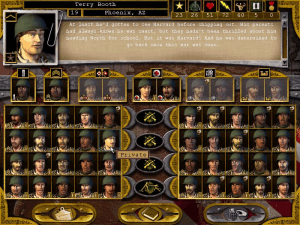
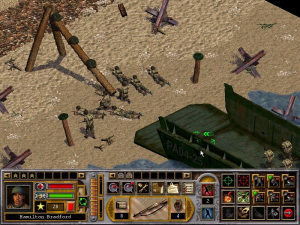
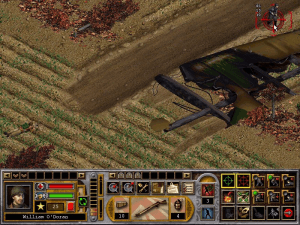
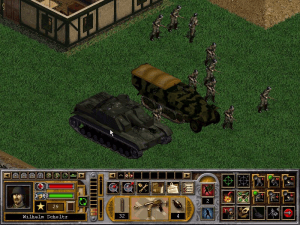
 186 MB
186 MB